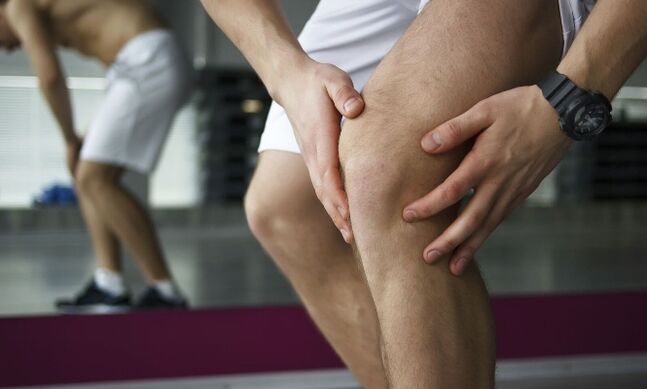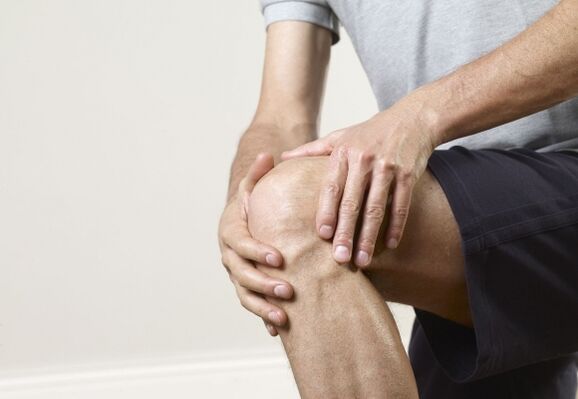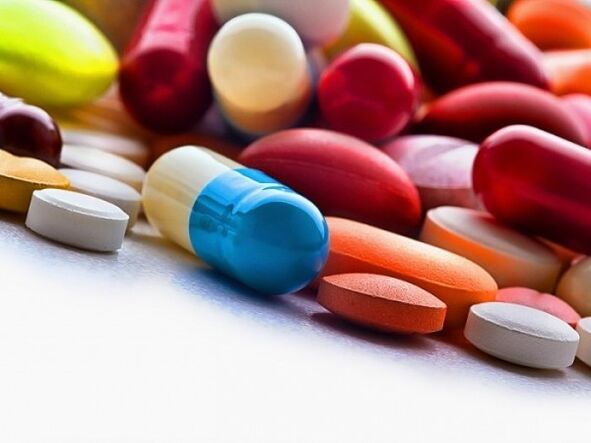The failure of any part of the locomotor organs, especially the knees, leads to the disruption of movement and balance of the body. Pain during movement of the knee joint (during flexion, extension, more lateral inward rotation, rotation, elevation and descent) can occur under different circumstances and under the influence of different factors. The strength of the pain syndrome, as well as its duration, differs depending on the depth of the injury, the etiology, and the pathogenesis of the pathology.

Specific painful and cracking sensations occur most often after physical exertion, trauma, or in the context of chronic somatic pathologies. After conducting medical therapy and eliminating the main cause, which is the origin of the pathology, pain and movement restrictions disappear. Otherwise, the prognosis is not reassuring: total or partial paralysis of the organ of movement can lead to lifelong disability.
What can hurt?
The anatomical design of the knee joint has its own characteristics that, in the event of any change, respond with pain. The knee joint includes a bony structure of the femur and tibia plus the patella. The marginal shape of each bone is endowed with condyles, its thickened shape and a certain relief create the conditions for an ideal biomechanics, a stable body balance in a horizontal position, as well as a safe movement with joint cushioning. The bones are reinforced with a special soft tissue plexus.
The muscles, its tendons, that hold the knee joint together, are directed from both the side of the thigh and the side of the lower leg. On the side of the thigh there is a thin muscle plus a large adductor, as well as the biceps femoris, semitendinosus and semimembranosus. The most powerful muscle of the knee joint structure is the quadriceps, in turn, it is divided into 4 muscle heads: straight, lateral width, medial width + intermediate width. The sartorian, lean, adductor, biceps femoris, semitendinosus + semimembranosus, as well as the triceps of the leg and popliteal muscles are also involved in the creation of the knee joint. Their combined plexus creates firmness, mobility and mobility of the lower extremities.
Attention!Forced violation of the integrity of the joint genus, such as rupture, shock, inflammation, destruction or infection, leads to the development of pain syndrome with limited motor function.
Within the genus articulatio, that is, the internal space of the joint consists of supraspinatus cartilaginous tissue, cruciate ligament, menisci, synovial bag. The blood supply and innervation of the knee joint are carried out through many complex plexuses. The sciatic, peroneal, tibial, and peroneal nerves are responsible for the sensation of the anterior and medial knee. The posterior part provides sensitivity to the tibial nerve with its branches.
The plexuses of the nerves and vessels (pulp and non-pulp nerve fibers) enter the menisci along its peripheral part of the cartilaginous plate and within it. With traumatization of the menisci, an acute pain syndrome develops, because the menisci are quite sensitive. As dystrophic processes develop in the genus of the joint, the pain grows and becomes permanent, and the organ itself loses its functionality plus the ability to move.
Risk factors and alarming symptoms
Knee pain develops as a result of certain risk factors involving special conditions associated with the general condition of the body, lifestyle, and harmful environmental factors. The risk group for pathologies of the articulatio genre accompanied by pain is made up of people with:
- genetic abnormalities;
- abnormalities in the development of cartilage and connective tissue;
- patients with pathologies of the central nervous system and peripheral nervous system;
- neurodysfunctions;
- obesity II, III - IV degree;
- diseases of the endocrine glands (thyrotoxicosis, hypothyroidism, diabetes mellitus, acromegaly, adrenal dysfunction);
- pathologies of the kidneys and liver (pyelonephritis, renal failure, urolithiasis, hepatitis B + C);
- allergic reactions to a variety of agents;
- bronchial asthma;
- reactive pathologies of the immune system.
An alarming symptom of pathology of the knee joint structure is a cracking noise during biomechanical actions such as flexion, extension or rotation. This symptom indicates the destruction of the joint, that is, a violation of metabolic processes, the abrasion of the supraspinatus cartilaginous plate of the distal portions of the bones, plus the thickening of the joint capsules with poor production of synovial fluid. Overweight with excessive stress on the knee joints or constant motor exploitation of the lower extremities gradually destroy the shock-absorbing structure of the locomotor organs, leading to destructive processes.

The causes of knee osteoarthritis or pain in the knee joints can be divided into three large groups, namely:
- Infectious and inflammatory type.
- Traumatic origin.
- Degenerative-dystrophic causes.
Gonarthrosis (inflammatory-destructive osteoarthritis) affects 65-70% of patients, of all patients with joint pathologies. Rheumatoid arthritis is second only to osteoarthritis and arthritis. The mechanism of pain development begins from the moment of damage to the cartilaginous periosteal tissue, the ligamentous plexus, the accumulation of fluid in the intra-articular space with leakage into the area of adjacent tissues, as well as due to a decrease in synovial lubrication. , pieces of bone, cartilage tissue, meniscus or other post-traumatic body. Acute pain appears after the nerve plexus is pinched as a result of injury or disproportionate physical exertion.
Inflammatory causes
Most often, inflammation of the articulatio genus (unilateral or bilateral) begins as a result of intense physical exertion, as well as against the background of other pathologies that lead to the deposition of salts in the joints or the leaching of Ca + cartilage. The latter is the trigger for the inflammatory process in the joints of the lower extremities.
Diseases of an inflammatory nature, symptoms:
| Inflammation of the ligament plexus and muscles of the knee joint (tendinitis) | Pathology occurs at an early age (16 to 28 years), as well as in physically active patients at the age of 30 to 45 years. Athletes often get sick. The pain is acute, with variable exacerbations. With the recession of inflammation, it becomes painful. At rest, the leg does not hurt, the slightest movement generates a sharp pain that increases rapidly. Motor function is partially or completely limited, it all depends on the degree of inflammation. |
| Knee arthritis | Inflammation of the genus articuldtio occurs suddenly after trauma, intoxication. The joint increases in volume, the skin is hyperemic and edematous. The pain syndrome is strong. Motor paralysis appears. A microbial infection can be involved in the process. After eliminating the cause, the pain disappears and the functionality of the knee is restored. |
| Bursitis articulatio genus | The list of causes is identical to the one for arthritis. The clinical picture is completely similar to inflammation of the knee joint. Treatment method: medication + surgical (puncture of the bursa, stress during suppuration / destruction). |
| Inflammation of certain muscle groups of the genus articuldtio or myositis | Intense sports or long walks cause muscle pain. A large accumulation of lactic acid in muscle tissue causes an inflammatory reaction in the muscles of the extremities and especially in the knee joints. The volume of the motor organ visually increases. On palpation, muscle compaction is felt, the patient reacts to acute pain by trying to remove the doctor's hand. The general condition of the patient is satisfactory, in some cases the temperature rises locally over the affected tissues and is common throughout the body (up to 38-39 degrees). After drug therapy, the pain disappears, the joint returns to its former shape + functionality. |
By eliminating the source of pathology by medication or surgical treatment, the functional capacity of the knee joint is restored and the acute or painful pain disappears completely. If the inflammatory process has attracted larger areas and the depth of the lesion is quite large, then the motor function can be partially restored. In some cases, a surgical restoration of the joint is performed.
Traumatic causes
Any injury of a mechanical nature can cause knee osteoarthritis. Contusions, compressions, fractures of the knee bones, open or closed injuries, as well as torn meniscus plus bursitis, torn ligaments, soft tissue contusion are included in the list of traumatic causes. Chemical and physical exposure can also cause knee pain. This group of causes includes burns, poisoning with toxic substances.
Causes of a degenerative-dystrophic nature.
There are several factors that can trigger the degenerative-dystrophic destruction mechanism with partial or irreversible processes in the knees, namely: constant physical activity with heavy lifting, excessive sports, injuries of any etiology. And also a sedentary lifestyle with improper nutrition, stressful situations. And finally: aging of the human body with alteration of the normal functioning of all systems and organs.
Pathologies that cause degeneration and destruction of the knee joint:
- Arthritis.
- Osteoarthritis
- Sclerotherapy of muscles, ligaments, ligaments, bags.
- Many osteophytes replace the cartilaginous plate.
- Meniscopathy
- Metabolic disease
- Dysfunction of the hormonal system.
- Heavy metal poisoning of the body.
Instead of the scraped cartilage, bare areas appear, that is, bare bone, which when the joint moves creates excruciating pain in the knee. After a certain period of time, sharp osteophytes develop in this area. Gradual deformation of the joint with gonarthrosis leads to a change in the anatomical configuration of the joint structure and to a partial or complete paralysis of the motor function of the knee (or knees). Symptoms of destructive knee osteoarthritis are sharp pain and constant crunching of the knee with soft tissue swelling.
Advice!Gonarthrosis of the degenerative-destructive type is not treated with folk remedies or an individually invented drug scheme, but only permanently under the strict guidance of doctors. Self-treatment will lead to a lifelong disability!
Pathology diagnosis and first aid.
The final diagnosis of pathology is made under stationary conditions. Through laboratory and instrumental studies, the causes of pain and the limitation of the biomechanics of the knees are determined. They address the diagnosis individually, because each case of morbidity has its own source + development mechanism, so not all patients are suitable for the same studies.
List of diagnostic measures:
- Performing general and biochemical blood tests.
- General urinalysis (if pyelonephritis and urolithiasis are suspected, other urinalysis is recommended).
- Testing to identify rheumatoid factor.
- Knee X-rays in three views.
- Computed tomography plus magnetic resonance imaging of the articuldtio genus to identify the degree of damage to bones, cartilage, and ligament-muscular apparatus.
Patients with knee osteoarthritis of unknown etiology are advised to consult the following physicians: orthopedic surgeon, arthrologist, rheumatologist, and endocrinologist. If there is a suspicion of a malignant process in the joints, the patient is referred to an oncologist.

First aid for acute knee joint pain is given at home or when you are injured. Before the arrival of an ambulance, the joint must be immobilized, that is, fixed with a splint. In addition, an intramuscular injection with an analgesic drug plus one of the non-steroidal anti-inflammatory drugs is recommended. A cold compress should be placed on the inflamed joint and in no case should it be heated or vasodilated. If the injury is open bleeding, apply a tourniquet above the knee to stop the bleeding.
Diseases of other organs, as a cause of knee pain.
Pain and impaired functional movements of the knee joints are not only the result of inflammation, osteoarthritis / arthritis or trauma, but a complication of concomitant pathologies. After a full course of medical therapy, the pain may decrease or disappear completely, it all depends on the remission of somatic diseases.
The list of diseases of organs and systems that provoke pain in the joint structures of the knee:
- Hepatitis B, C
- Thyrotoxicosis
- Hypothyroidism
- Diabetes
- Urolithiasis disease
- Bronchial asthma
- Crohn's disease
- Blood disease
- Strokes
The anamnesis, the most instrumental laboratory studies help to determine the cause. Each pathology has its own treatment regimen. It is appointed by a doctor after receiving the results of the investigation.
Varieties of pain
Pain in the defeat of the knee joints is completely different, it depends on the cause, localization, attraction of soft tissues and microbial infection, as well as the degree of destruction of the joint. By the nature of painful sensations it can be: sharp, stabbing, painful. By location: from the inside, outside, front, back of the knee joint, as well as above and below the patella. By type of spread: pain is strictly localized or radiates to the thigh or lower leg. By duration: temporary, permanent, variable.
How to get rid of knee pain
Before starting therapeutic therapy, the exact cause of the pathology is discovered, after discovering the source, they begin to eliminate it and stabilize the general condition. The therapy consists of a complex of drug treatment, physiotherapy (according to medical indications), exercise therapy, massage and time-tested folk remedies.
Medicine
All the forces of treatment are aimed at eliminating the cause of the pain and then treating the underlying disease. In parallel, you can use drugs in the form of ointments, gels, local compresses. In the first days of acute pain, it is recommended to administer the drug intravenously or intramuscularly. After tapering off, you can switch to oral administration.

The complex of therapeutic measures consists of:
- Pain relief for affected joints.
- Eliminate knee inflammation.
- Restorative measures of a biomechanical nature, that is, the motor function of the articulatio genus.
- Treatment of the pathology leading to pain in the knees (the treatment regimen is prescribed by the attending physician or highly specialized specialists, such as an endocrinologist, hepatologist, allergist, rheumatologist, arthrologist, oncologist).
- Increasing the resistance of the body.
- Normalization of metabolism.
- Hepatoprotectors.
- Restoration of the cartilaginous periosteal layer and normalization of synovial fluid production (use of the latest generation chondroprotectors, vitamins B and C, D).
Attention!Obese patients are advised to lose those extra pounds through special diets prescribed by a dietitian. All people, without exception, should reduce the load on the lower extremities, working smoothly.
Therapeutic gymnastics and massages
The constant passive movements of the diseased joint and the massage of the inflamed organs of movement in 1-1. 5 months will restore the function of the lower extremities. The set of exercises is chosen by the specialist in physiotherapy. The massage is performed locally only on the joints of the legs or of a general nature. Using hot, anti-inflammatory, or pain reliever ointments will improve blood circulation and metabolism. The course of massage procedures depends on the speed of recovery of the organ. In addition, a special diet is applied to these activities, excluding fried, fatty, sweet, sour. The nutritionist adjusts the menu by adding gelatin-rich dishes in the form of fractional meals. All procedures in the complex in one course of treatment will eradicate pain and paralysis of the knee joints.
Home remedies
Grandma's techniques in the form of folk recipes can be used in parallel with drug therapy. All funds are negotiated with the treating physician and applied locally directly to the affected joint. The effect of folk remedies is aimed at eliminating pain + edema, as well as warming, which in turn improves blood supply, innervation and intensely nourishes knee pain.
Popular home remedies:
- Herbal baths: celandine, chamomile, mint, wormwood + ginseng root. The ingredients are taken in a spoon, poured with boiling water in an amount of 1 liter, and then brewed for 2-3 minutes. At a tolerable temperature, a foot bath is performed.
- Baking soda compress: a tablespoon of baking soda per 1 liter of boiling water. After abundant lubrication of the knee with a reinforced cream, a compress is applied overnight.
- Moon liqueur and grated potatoes compress: half a kilo of grated potatoes + 0. 5 moon liqueur. It is recommended to save one hour. It is repeated 3-4 times a week until the pain and swelling disappear.
- Honey ointment: 200g of honey + 100ml of vodka + 200g of grated horseradish. It is insisted for a day. Sore joints are rubbed 2 to 5 times a day.
Patients with an increased reaction to certain herbs or substances should refrain from traditional medicine.
Prophylaxis
For preventive purposes, in order for the lower extremities to be healthy until old age, it is recommended to adjust the nutritional diet, be careful when moving, exclude injuries, constantly play sports, swim and walk more often in the fresh air. People over the age of 45 are advised to adjust the hormonal background of sex hormones, in addition to eating foods rich in gelatin. Spa treatments are recommended for all patients with musculoskeletal problems. Once every six months, undergo an examination by the attending physician.
Pain in the knee joints occurs spontaneously, it is the result of increased wear and tear on the joint structure, which leads to irreversible consequences. The reasons for the development of pathologies can be both somatic diseases and pathologies of the locomotor system itself. Timely treatment will help avoid the consequences.



































